iowa

 Most people, these days, have probably never heard of Marion Robert Morrison, although I’ll bet that most people have seen at least one of his movies, or at the very least a commercial advertising one of his movies on some of the old movie channels. Maybe if I said that his name was John Wayne or even The Duke (his famous nickname), more people would recognize the famous American West actor. John Wayne actually became the epitome of the American West. Wayne was born on May 26, 1907, at 224 South Second Street in Winterset, Iowa, to Clyde Leonard Morrison (1884–1937), who was the son of American Civil War veteran Marion Mitchell Morrison (1845–1915), and the former Mary “Molly” Alberta Brown (1885–1970), who was from Lancaster County, Nebraska. He weighed a whopping 13 pounds at birth. Wayne claimed his middle name was soon changed from Robert to Michael when his parents decided to name their next son Robert. That fact, if it is a fact, cannot be confirmed even with extensive research, because no such legal change was found. Wayne’s legal name remained Marion Robert Morrison his entire life, but he often went by Marion Michael Morrison…before becoming John Wayne.
Most people, these days, have probably never heard of Marion Robert Morrison, although I’ll bet that most people have seen at least one of his movies, or at the very least a commercial advertising one of his movies on some of the old movie channels. Maybe if I said that his name was John Wayne or even The Duke (his famous nickname), more people would recognize the famous American West actor. John Wayne actually became the epitome of the American West. Wayne was born on May 26, 1907, at 224 South Second Street in Winterset, Iowa, to Clyde Leonard Morrison (1884–1937), who was the son of American Civil War veteran Marion Mitchell Morrison (1845–1915), and the former Mary “Molly” Alberta Brown (1885–1970), who was from Lancaster County, Nebraska. He weighed a whopping 13 pounds at birth. Wayne claimed his middle name was soon changed from Robert to Michael when his parents decided to name their next son Robert. That fact, if it is a fact, cannot be confirmed even with extensive research, because no such legal change was found. Wayne’s legal name remained Marion Robert Morrison his entire life, but he often went by Marion Michael Morrison…before becoming John Wayne.
When he was six years old, Wayne’s family moved to Glendale, California, where he like many teens in those days, had a paper route that got him up at four in the morning to deliver newspapers. After school, he played football and made deliveries for local stores. After high school, he had big ambitions to attend the U.S. Naval Academy, but his dreams were dashed when they rejected him. Then, he accepted a full scholarship to play football at the University of Southern California in Los Angeles, which is quite likely the very thing that led to his entire future, and not in football or academics.
For most football players, having a job isn’t an easy feat, because of the football and study schedules, so in the summer of 1926, Wayne’s football coach found him a job as an assistant prop man on the set of a movie directed by John Ford. Ford saw something more is the handsome young football player, and he started to use Wayne as an extra in his films. It’s strange, maybe, that I think that John Wayne became more handsome as he got older. The younger verson, while handsome, lacked the character that really defines some men. That led to larger roles, and in 1930, Ford recommended John Wayne for Fox’s epic Western, “The Big Trail.” Wayne won the part, but the movie did poorly, and Fox let his contract lapse. That didn’t deter John Wayne, who had by then been bitten by the acting bug. Over the next decade, he worked tirelessly on a number of low-budget films, to improve his acting abilities, and in the end, his old friend and mentor, John Ford gave him his big break, when he cast him in the 1939 western, “Stagecoach.” The rest is history, as John Wayne starred in more than 77 movies. Including my favorites, “Maclintock,” “True Grit,” “The Sons of Katie Elder,” and “Hell Fighters.” While John Wayne got his start in Westerns, he also did a number of military movies. It wasn’t hard to transition from a valiant cowboy or cavalry soldier to the brave WWII fighters of films like Sands of Iwo Jima (1949) and Flying Leathernecks (1951). John Wayne was deeply conservative in his politics, and he used his 1968 film, The Green Berets, to express his support of the American government’s war in Vietnam.
Unfortunately, by the late 1960s, some Americans had tired of Wayne and his simplistically masculine and patriotic characters. I simply cannot understand that at all, except that people had started to look for the increasingly sinister in movies. Sadly, western movies began rejecting the simple black-and-white moral codes championed by Wayne and replacing them with a more complex and tragic view of the American West…not a good move for the people. Nevertheless, John Wayne proved more adaptable than many expected. True Grit 
 (1969) allowed him to escape the narrow confines of his own good-guy image, but still remain basically “the good guy” in reality. Nevertheless, John Wayne was entering the final years of his life, whether he knew it or not. His final film, The Shootist (1976), proved once and for all that he was an actor who had earned the right to be called elite, when he won over even his most severe critics. At the time of the filming of “The Shootist,” John Wayne was battling lung cancer, while playing the part of a dying gunfighter whose moral codes and principles no longer fit in a changing world. Three years later, Wayne died of cancer. To this day, public polls identify him as one of the most popular actors of all time.
(1969) allowed him to escape the narrow confines of his own good-guy image, but still remain basically “the good guy” in reality. Nevertheless, John Wayne was entering the final years of his life, whether he knew it or not. His final film, The Shootist (1976), proved once and for all that he was an actor who had earned the right to be called elite, when he won over even his most severe critics. At the time of the filming of “The Shootist,” John Wayne was battling lung cancer, while playing the part of a dying gunfighter whose moral codes and principles no longer fit in a changing world. Three years later, Wayne died of cancer. To this day, public polls identify him as one of the most popular actors of all time.
 What would the modern farm be without the tractor? People in the 19th century knew exactly what it would be, even if they had no idea what a tractor was. John Froelich was born on November 24, 1849, in Iowa. His life would end up changing much in the agricultural industry. As an adult, Froelich operated a grain elevator and mobile threshing service. His job was to bring a crew to local farms every year at harvest time. He hired a crew and dragged a heavy steam-powered thresher through Iowa and the Dakotas, threshing farmers’ crops for a fee. I suppose it was a good way to make a living, but his machine was bulky, hard to transport, and expensive to use. To top it off, it was also dangerous…one spark from the boiler on a windy day, and he could find the whole prairie ablaze.
What would the modern farm be without the tractor? People in the 19th century knew exactly what it would be, even if they had no idea what a tractor was. John Froelich was born on November 24, 1849, in Iowa. His life would end up changing much in the agricultural industry. As an adult, Froelich operated a grain elevator and mobile threshing service. His job was to bring a crew to local farms every year at harvest time. He hired a crew and dragged a heavy steam-powered thresher through Iowa and the Dakotas, threshing farmers’ crops for a fee. I suppose it was a good way to make a living, but his machine was bulky, hard to transport, and expensive to use. To top it off, it was also dangerous…one spark from the boiler on a windy day, and he could find the whole prairie ablaze.
Froelich knew that this was no way to do business. He decided that he had to try something new. In 1890, instead of that cumbersome, hazardous steam engine, Froelich came up with the idea of a gas powered engine. The size comparison alone made it a far superior choice. So, he and his blacksmith mounted a one-cylinder gasoline engine on his steam engine’s running gear and set off for a nearby field to see if it worked. To their excitement, it did. The tractor 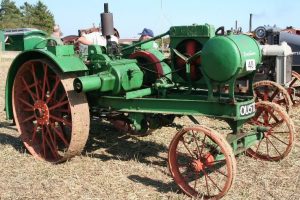 Traveled at a speed of three miles per hour. Of course, that was going to take them a long time to go from one location to another. The real test came when they took their new machine on the road for the annual threshing season. The good news is that the machine was a success there too. The crew threshed more than a thousand bushes of grain every day, 72,000 bushels in all, and they used only 26 gallons of gasoline. Of even greater importance, was that they did the whole thing without one fire.
Traveled at a speed of three miles per hour. Of course, that was going to take them a long time to go from one location to another. The real test came when they took their new machine on the road for the annual threshing season. The good news is that the machine was a success there too. The crew threshed more than a thousand bushes of grain every day, 72,000 bushels in all, and they used only 26 gallons of gasoline. Of even greater importance, was that they did the whole thing without one fire.
It was time to take the project to the next level. Froelich found eight investors, and they formed the Waterloo Gasoline Traction Engine Company. They built four prototype tractors and sold two. Unfortunately, both were soon returned. Rather than lose the company, and to make money, the company branched out into stationary engines. That was somewhat more successful and its first engine powered a printing press at the Waterloo Courier newspaper. Froelich was happy 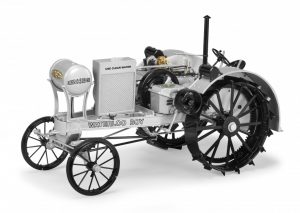 with the success, but that was really not where his interests were. He was into farming equipment and wanted to make an engine that worked for that. So he left the company in 1895. Froelich might have jumped the gun a little bit, because Waterloo kept working on its tractor designs. The designs still weren’t wildly successful, and between 1896 and 1914, Waterloo sold just 20 tractors in all. Success finally came when in 1914, the company introduced its first Waterloo Boy Model “R” single-speed tractor, which sold very well…118 in 1914 alone. The next year, its two-speed Model “N” was even more successful. In 1918, the John Deere plow-manufacturing company bought Waterloo for $2,350,000.
with the success, but that was really not where his interests were. He was into farming equipment and wanted to make an engine that worked for that. So he left the company in 1895. Froelich might have jumped the gun a little bit, because Waterloo kept working on its tractor designs. The designs still weren’t wildly successful, and between 1896 and 1914, Waterloo sold just 20 tractors in all. Success finally came when in 1914, the company introduced its first Waterloo Boy Model “R” single-speed tractor, which sold very well…118 in 1914 alone. The next year, its two-speed Model “N” was even more successful. In 1918, the John Deere plow-manufacturing company bought Waterloo for $2,350,000.
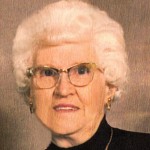
 On July 19, 1989, in the skies over Alta, Iowa, United Airlines Flight 232, on which my great aunt, Gladys Cooper was a passenger, began the fateful journey to a catastrophic end. At 3:16pm, the rear engine’s fan disk broke apart due to a previously undetected metallurgical defect located in a critical area of the titanium-alloy. Basically that meant that the fan disk shattered, sending shrapnel through the hydraulic lines of all three independent hydraulic systems on board the aircraft. This horrific event caused the rapid loss of all the hydraulic fluid. The subsequent catastrophic disintegration of the disk had resulted in a spray of debris with energy levels that exceeded the level of protection provided by design features of the hydraulic systems that operate the DC-10’s flight controls. The flight crew lost its ability to operate nearly all of them. In the resulting crash landing, the right wing just tapped the runway, causing the plane to cartwheel and break apart as it went careening down the runway and into a corn field. While my Great Aunt Gladys was killed in the crash, the skill of the pilot and flight crew saved 185 lives, including their own.
On July 19, 1989, in the skies over Alta, Iowa, United Airlines Flight 232, on which my great aunt, Gladys Cooper was a passenger, began the fateful journey to a catastrophic end. At 3:16pm, the rear engine’s fan disk broke apart due to a previously undetected metallurgical defect located in a critical area of the titanium-alloy. Basically that meant that the fan disk shattered, sending shrapnel through the hydraulic lines of all three independent hydraulic systems on board the aircraft. This horrific event caused the rapid loss of all the hydraulic fluid. The subsequent catastrophic disintegration of the disk had resulted in a spray of debris with energy levels that exceeded the level of protection provided by design features of the hydraulic systems that operate the DC-10’s flight controls. The flight crew lost its ability to operate nearly all of them. In the resulting crash landing, the right wing just tapped the runway, causing the plane to cartwheel and break apart as it went careening down the runway and into a corn field. While my Great Aunt Gladys was killed in the crash, the skill of the pilot and flight crew saved 185 lives, including their own.
While listening to an audio book about World War II, and what happens when bombers flew through flak (Fl(ieger)a(bwehr)k(anone)). I knew that on at least one occasion, my dad, Allen Spencer, a Flight Engineer and Top Turret Gunner on a B-17 in World War II, was tasked with the job of cranking down the landing gear for landing. I don’t know what I had been thinking happened to the landing gear, maybe a close bit of flak the bent something in the gear perhaps, but what had not occurred to me was a catastrophic hit of that flak, causing all hydraulics to be lost. Nevertheless, quite likely that is what happened. It was one of the scenarios discussed in the book. As the hydraulics were lost, the red fluid was all over the floor of the aircraft, and the next thing that was required was to crank down the landing gear, because the gear could not be lowered without hydraulic fluid. Somehow, Dad’s precarious position of hanging out in the open bomb bay doors seemed like such a simple solution to the problem, albeit a heroic act, but the loss of hydraulics could have meant death to the crew. Getting the landing gear down was only part of the problem. What about the flaps, brakes, and such. These planes were in a really bad way.
Of course, my dad’s plane did land safely, given that he became my dad, but years later, when my mother, Collene Spencer’s Aunt Gladys was on a plane crippled by the loss of all hydraulics, I now realize…finally, that when my dad heard about what happened with Flight 232, as we all eventually did, he understood full well, 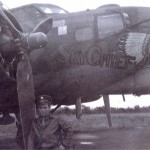
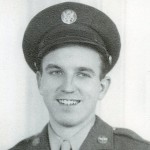 what the flight crew had been faced with. Something I only understood from the view of a spectator…for lack of a better word. He had been there. The Flight 232 situation quite likely took my dad back some 45 years to that day when he had to crank down the landing gear on a B-17 Bomber that had been damaged by flak, probably spilling hydraulic fluid all over the floor where the crew was standing. The experience must have been awful to go through, and the thought of what happened to Flight 232, almost as bad. And yet, in typical World War II veteran style, Dad said nothing, but rather set about comforting his family over the loss.
what the flight crew had been faced with. Something I only understood from the view of a spectator…for lack of a better word. He had been there. The Flight 232 situation quite likely took my dad back some 45 years to that day when he had to crank down the landing gear on a B-17 Bomber that had been damaged by flak, probably spilling hydraulic fluid all over the floor where the crew was standing. The experience must have been awful to go through, and the thought of what happened to Flight 232, almost as bad. And yet, in typical World War II veteran style, Dad said nothing, but rather set about comforting his family over the loss.

 Yesterday, while watching television, one of the shows I like to watch…Why Planes Crash…came on. This particular episode included the cause of Flight 232 in Sioux City, Iowa. This particular crash had an enormous impact on my own life, and that of my mother’s family. It was the one in which my Great Aunt Gladys Pattan Byer Cooper was killed. I have watched the footage numerous times, as well as the episode of Why Planes Crash that contained the answer, but it seems that each time, I learn something new about the crash. I’m not sure why some of the information didn’t stick in my head the first time it was aired, because it most certainly was information that was pointed out. Nevertheless, it didn’t stick in my head that first time or even the subsequent times…until now.
Yesterday, while watching television, one of the shows I like to watch…Why Planes Crash…came on. This particular episode included the cause of Flight 232 in Sioux City, Iowa. This particular crash had an enormous impact on my own life, and that of my mother’s family. It was the one in which my Great Aunt Gladys Pattan Byer Cooper was killed. I have watched the footage numerous times, as well as the episode of Why Planes Crash that contained the answer, but it seems that each time, I learn something new about the crash. I’m not sure why some of the information didn’t stick in my head the first time it was aired, because it most certainly was information that was pointed out. Nevertheless, it didn’t stick in my head that first time or even the subsequent times…until now.
I have often wondered why it takes so long to find the cause of some of the plane crashes…especially the ones where there were survivors and where the black box was so easily found, but sometimes it just does take time. One of the possibilities is that some of the tiny parts, or even large parts of the plane seem to be missing. That was the case with Flight 232. The entire fan disk of its tail mounted General Electric CF6-6 engine failed and disintegrated. I’m sure that the investigators knew that something happened to the fan disk, but without it,  they could not say what happened. The initial explosion that was heard was over Alta, Iowa…about 60 miles from their final crash site in Sioux City, Iowa. This was the point when the fan disk disintegrated. Now, 60 miles may not seem like such a large distance, but add to that the fact that the plane circled around trying to burn up it’s fuel, and trying to stay upright, and the fact that when the fan disk disintegrated, it was traveling at a tremendous amount of speed. In the end, the fan disk was discovered quite by accident three months later, on October 10, 1989, when Janice Sorenson, a farmer harvesting corn near Alta, Iowa, felt resistance on her combine, and after getting out to investigate, discovered most of the fan disk with a number of blades still attached partially buried in her cornfield. The rest of the fan disk and most of the additional blades were located later in the harvest. That would be the point that the investigation could finally bring to a conclusion the actual cause of the crash that had taken my great aunt’s life.
they could not say what happened. The initial explosion that was heard was over Alta, Iowa…about 60 miles from their final crash site in Sioux City, Iowa. This was the point when the fan disk disintegrated. Now, 60 miles may not seem like such a large distance, but add to that the fact that the plane circled around trying to burn up it’s fuel, and trying to stay upright, and the fact that when the fan disk disintegrated, it was traveling at a tremendous amount of speed. In the end, the fan disk was discovered quite by accident three months later, on October 10, 1989, when Janice Sorenson, a farmer harvesting corn near Alta, Iowa, felt resistance on her combine, and after getting out to investigate, discovered most of the fan disk with a number of blades still attached partially buried in her cornfield. The rest of the fan disk and most of the additional blades were located later in the harvest. That would be the point that the investigation could finally bring to a conclusion the actual cause of the crash that had taken my great aunt’s life.
That event has always been a little fuzzy for me. Not the crash, or even the loss of Aunt Gladys, but the whole investigation. For years I’m not sure I really wrapped my mind around the cause of the crash…at least not until I saw the animated reenactment of the crash. Then it became crystal clear what had happened. The breaking 
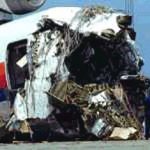 up of the fan disk, caused by a crack that happened when the disk was made, due to impurities in the Titanium, brought down the plane. The crew, including a flight instructor who happened to be onboard, did an amazing job in their efforts not to crash. In the end, it would be on slight dip of the wind caused by a failed hydraulic system that would cause it to tap the ground and cartwheel the plane. It was the event that would forever change our family, from one who had never had someone killed in an airplane crash, to one the had. We would never forget it, and we deeply miss Aunt Gladys to this day.
up of the fan disk, caused by a crack that happened when the disk was made, due to impurities in the Titanium, brought down the plane. The crew, including a flight instructor who happened to be onboard, did an amazing job in their efforts not to crash. In the end, it would be on slight dip of the wind caused by a failed hydraulic system that would cause it to tap the ground and cartwheel the plane. It was the event that would forever change our family, from one who had never had someone killed in an airplane crash, to one the had. We would never forget it, and we deeply miss Aunt Gladys to this day.
 Years ago, many people thought that anyone who was trying to invent an airplane was pretty much insane…saying, that “if man were meant to fly, God would have given him wings” as their reasoning. I’m sure that those same people reiterated their thoughts on the matter, with each new plane crash…basically jumping on the chance to say, “I told you so!” Of course, these days, no one thinks that way, whether they like to fly or not. I guess a fear of flying and the idea that it is a foolish pipe dream aren’t the same things at all. Still, while man has proven over the years that flight is possible, and in fact mostly safe, there are some airplane crashes that that will forever be embedded in our minds. For me, of course, the one that I can picture in my mind at the drop of a hat, is Flight 232 that crashed in Sioux City, Iowa. This was the crash that took the life of my Great Aunt Gladys Pattan Byer Cooper. That pilot was so close to landing that plane safely, and would have, in fact, if the plane hadn’t put in one last effort to turn over due to a major loss of hydraulics. The resulting crash made me wonder how anyone survived…much less the 185 out of 296 people on board. The only reason they survived was the skill of the pilot…and much prayer.
Years ago, many people thought that anyone who was trying to invent an airplane was pretty much insane…saying, that “if man were meant to fly, God would have given him wings” as their reasoning. I’m sure that those same people reiterated their thoughts on the matter, with each new plane crash…basically jumping on the chance to say, “I told you so!” Of course, these days, no one thinks that way, whether they like to fly or not. I guess a fear of flying and the idea that it is a foolish pipe dream aren’t the same things at all. Still, while man has proven over the years that flight is possible, and in fact mostly safe, there are some airplane crashes that that will forever be embedded in our minds. For me, of course, the one that I can picture in my mind at the drop of a hat, is Flight 232 that crashed in Sioux City, Iowa. This was the crash that took the life of my Great Aunt Gladys Pattan Byer Cooper. That pilot was so close to landing that plane safely, and would have, in fact, if the plane hadn’t put in one last effort to turn over due to a major loss of hydraulics. The resulting crash made me wonder how anyone survived…much less the 185 out of 296 people on board. The only reason they survived was the skill of the pilot…and much prayer.
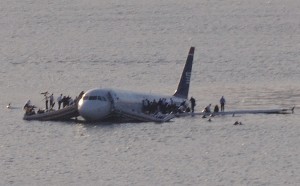
Another plane crash that has stayed in my memory was the crash of the Concorde, that occurred on this day, July 25, 2000. The Concord was a beautiful plane, and by far the most luxurious one of its time. I’m not sure there are even any planes that are more luxurious today…although the Boeing 787 might be. Dubbed the Dreamliner, it gives the indication that it might out class the Concorde. Nevertheless, in its day, the Concorde was the end all, beat all of airplanes. The thing that always amazes me is that sometimes it is the tiniest of things that ends up bringing down a plane. Much like the bird strike that brought down US Airways Flight 1549 on the Hudson River.
The Concorde was downed be a small piece of metal on the runway…that had fallen off of another plane. Air France Flight 4590 left DE Gaulle Airport for New York carrying nine crew members and 96 German tourists who were planning to take a cruise to Ecuador. That piece of metal shredded the tire that ran over it, throwing  pieces of the tire into one of the engines and fuel tanks, causing a disabling fire. The pilot had no idea what was about to happen, but just moments later the plane plunged to the ground near a hotel in Gonesse, France. A huge fireball erupted and all 105 people on the plane were killed immediately. The Concorde, the world’s fastest commercial jet, had enjoyed an exemplary safety record up to that point, with no crashes in the plane’s 31 year history. That crash, however, marked the beginning of the end for the Concorde. The last flight of the Concorde was on October 24, 2003. What was supposed to mark the first of a future of supersonic, fast paced air travel, was brought to a disappointing halt. Air travel has taken on a much slower pace since that time.
pieces of the tire into one of the engines and fuel tanks, causing a disabling fire. The pilot had no idea what was about to happen, but just moments later the plane plunged to the ground near a hotel in Gonesse, France. A huge fireball erupted and all 105 people on the plane were killed immediately. The Concorde, the world’s fastest commercial jet, had enjoyed an exemplary safety record up to that point, with no crashes in the plane’s 31 year history. That crash, however, marked the beginning of the end for the Concorde. The last flight of the Concorde was on October 24, 2003. What was supposed to mark the first of a future of supersonic, fast paced air travel, was brought to a disappointing halt. Air travel has taken on a much slower pace since that time.
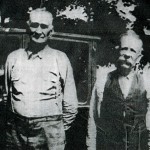 After my 2nd great grandfather, Allen Spencer passed away suddenly at the young age of just 56 years, my 2nd great grandmother, Lydia Spencer found herself in one of the hardest positions anyone ever has to face. In those days, few of the women worked outside the home, and with her husband and the bread winner of her family gone, she had some hard choices to make. She still had several children at home, including three sons and one daughter. Her daughter, Teresa would marry later that year, and eventually move to North Dakota. Her son Allen would follow his sister to North Dakota, and eventually move to Washington, where he would marry and live out his life. That left Lydia in Iowa, with her two remaining sons, Cornelius and Luther…at least for a time. That had to have been the hardest part of the time too, considering the grief she must have been feeing.
After my 2nd great grandfather, Allen Spencer passed away suddenly at the young age of just 56 years, my 2nd great grandmother, Lydia Spencer found herself in one of the hardest positions anyone ever has to face. In those days, few of the women worked outside the home, and with her husband and the bread winner of her family gone, she had some hard choices to make. She still had several children at home, including three sons and one daughter. Her daughter, Teresa would marry later that year, and eventually move to North Dakota. Her son Allen would follow his sister to North Dakota, and eventually move to Washington, where he would marry and live out his life. That left Lydia in Iowa, with her two remaining sons, Cornelius and Luther…at least for a time. That had to have been the hardest part of the time too, considering the grief she must have been feeing.
Luther married Ellen Dykes in 1885, and Cornealius married Leona Stinson on February 1, 1888. By 1900, the two brothers along with their families and their mother had moved to the Deer Creek, Oklahoma area. I know that in the years following their fathers death, these two men took on the role of caregiver of sorts for their mother. It wasn’t necessarily that she needed a caregiver, at only 53 years of age, but rather that these two brothers took on the role of picking up the pieces of her shattered life and helping her through the rough transition years, during which she went from being a wife to a widow. It isn’t that she was incapable, but it would be really hard to find yourself widowed at such a young age. You had thought you and your souse would grow old together, and now you have been left to try to figure out how to move on alone.
Little has been said about the role the two brothers played in her life, and I suppose that is because it was just expected of them and so everyone assumed they just did their job. I suppose that is true to a large degree, but there were other children in the family, and yet they chose to take on this role, and she chose to go to Oklahoma with these two sons, rather than move to North Dakota, Wisconsin, or Washington with her other children. She loved the others very much, and the pictures tell me that she saw them whenever she could, but she moved to Oklahoma with Cornealius and Luther, and lived in Luther’s home until her passing in 1906, at the age of 75.
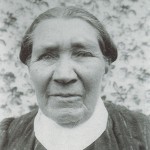 It takes a very special person to move their elderly parent into their home, and I don’t just mean that parent’s child, but the spouse of that child too. You can’t take in your parent without the ok of your spouse, because this is going to affect the whole family. In this case, it is likely that the time Lydia lived with her son Luther and his family in Oklahoma, was about ten years, but in reality, that is a long time. The last days could have been very stressful and trying, given the way, aging parents get weak and tired as they get closer to death. Yes, I think that Luther and his wife, Ellen had to be very special people to make sure that Lydia was taken care of, and not lonely. I’m sure that went a long way toward picking up the pieces of her life, after the loss of her husband, Allen. That leaves me with a lot of respect for these sons and their families.
It takes a very special person to move their elderly parent into their home, and I don’t just mean that parent’s child, but the spouse of that child too. You can’t take in your parent without the ok of your spouse, because this is going to affect the whole family. In this case, it is likely that the time Lydia lived with her son Luther and his family in Oklahoma, was about ten years, but in reality, that is a long time. The last days could have been very stressful and trying, given the way, aging parents get weak and tired as they get closer to death. Yes, I think that Luther and his wife, Ellen had to be very special people to make sure that Lydia was taken care of, and not lonely. I’m sure that went a long way toward picking up the pieces of her life, after the loss of her husband, Allen. That leaves me with a lot of respect for these sons and their families.
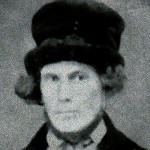 My great great grandfather, Allen Spencer and my great great grandmother, Lydia Quackenbush Potts Spencer were married on February 22, 1850 in Canastota, New York. It didn’t take them too many years to decide that New York was not where they wanted to be. So, in the spring of 1855, after the birth of their second child, Ida, who was born June 11, 1854, they packed up their belongings and their two children, and headed west. They had their hearts set on Iowa. It would be a long journey, traveling on dirt roads, camping underneath the stars, cooking over a campfire, and often going for days without seeing other people. They would have had to cross rivers with no bridges, traveling for miles sometimes before finding a place where it was safe to take the covered wagon across. Then traveling back to where they had been before. They would have most likely crossed the Mississippi at Prairie Du Chien, which was the only place north of Saint Louis to have a ferry at that time. I imagine that it seemed very odd to be around what seemed like so many people again. Then, probably after a few days, they set off again for their dream home…Iowa. It is unsure if they arrived in Iowa in 1855, or if they wintered in Prairie Du Chien before going on in the spring of 1856, but apparently Iowa was not quite what they expected, because it was not long before the family would again move…this time to Wisconsin. My great grandfather, William was born in Iowa on August 27, 1857, but by the time their next child, Luther was born on May 18, 1858, the family was living in Wisconsin.
My great great grandfather, Allen Spencer and my great great grandmother, Lydia Quackenbush Potts Spencer were married on February 22, 1850 in Canastota, New York. It didn’t take them too many years to decide that New York was not where they wanted to be. So, in the spring of 1855, after the birth of their second child, Ida, who was born June 11, 1854, they packed up their belongings and their two children, and headed west. They had their hearts set on Iowa. It would be a long journey, traveling on dirt roads, camping underneath the stars, cooking over a campfire, and often going for days without seeing other people. They would have had to cross rivers with no bridges, traveling for miles sometimes before finding a place where it was safe to take the covered wagon across. Then traveling back to where they had been before. They would have most likely crossed the Mississippi at Prairie Du Chien, which was the only place north of Saint Louis to have a ferry at that time. I imagine that it seemed very odd to be around what seemed like so many people again. Then, probably after a few days, they set off again for their dream home…Iowa. It is unsure if they arrived in Iowa in 1855, or if they wintered in Prairie Du Chien before going on in the spring of 1856, but apparently Iowa was not quite what they expected, because it was not long before the family would again move…this time to Wisconsin. My great grandfather, William was born in Iowa on August 27, 1857, but by the time their next child, Luther was born on May 18, 1858, the family was living in Wisconsin.
Having driven through Iowa recently, I can say that it is pretty flat, and at least to me, not very interesting. I suppose it was a matter of what you were looking for. Farming country wasn’t exactly what this city girl had in mind for life, which is probably why I chose to stay in Wyoming…country enough to be small and city enough to have things to do. Still, Iowa does appeal to a lot of people and in the end, it must have appealed to my great great grandparents again, because Webster City, Iowa would be where my great great grandfather, Allen Spencer would pass away, and where he is buried. My great great grandmother, Lydia Quackenbush Potts  Spencer would again move on, this time to Fay, Oklahoma, where her sons lived and would pass away there twenty three years after the passing of her husband, Allen Spencer, and after seeing her many grandchildren.
Spencer would again move on, this time to Fay, Oklahoma, where her sons lived and would pass away there twenty three years after the passing of her husband, Allen Spencer, and after seeing her many grandchildren.
I don’t know if they found the winters in Wisconsin too harsh, the growing season too short, or exactly what drew them back to Iowa, but I guess it was their dream in the beginning and their dream in the end…or at least until Allen’s death. Then maybe Lydia could no longer bear to stay, or maybe she only left because of her sons. I’ll probably never know for sure, but I can relate to being near family…especially after a loss, so that is my guess as to what my great great grandmother would have wanted.
 When I come across a husband and wife, who both died on the same day, my curiosity kicks into overdrive. That just seems so unusual. Nevertheless, such was the case for my husband, Bob’s 4th great grandparents, Cloudsbury and Elizabeth Kirby, both of whom died on August 29, 1878 in Mount Ayr, Ringgold County, Iowa. At first, I wondered if it was an error, and I suppose it could be, but that is the information I have at this point, so that is what I have to go with.
When I come across a husband and wife, who both died on the same day, my curiosity kicks into overdrive. That just seems so unusual. Nevertheless, such was the case for my husband, Bob’s 4th great grandparents, Cloudsbury and Elizabeth Kirby, both of whom died on August 29, 1878 in Mount Ayr, Ringgold County, Iowa. At first, I wondered if it was an error, and I suppose it could be, but that is the information I have at this point, so that is what I have to go with.
My first thought was to check for disasters in the area, like tornados, fires, or floods, but I was unable to find anything that specifically happened in Mount Ayr, Iowa on August 29, 1878. Looking for these kinds of specific things can be a long and frustrating process, but I just can’t imagine too many situations where both halves of a couple would pass on the same day. I searched and found that there were tornadoes during that year, but nothing specifically on that day, so I doubt that a tornado is the culprit here.
When the possibility of a disaster was removed, I began to think about illness, so I looked up and epidemics in the area. That is when I came across a definite possibility…the Yellow Fever Epidemic of 1876 to 1878, which took many lives in the southern United States. Yellow fever, known historically as yellow jack or yellow plague is an acute viral disease, that is usually spread by the female mosquito. Symptoms include fever, chills, loss of appetite, nausea, muscle pains particularly in the back, and headaches. Many people improve after a few days, but when the symptoms return, they can cause kidney damage, liver failure (causing yellow skin, probably the reason for the name Yellow Fever), bleeding, and ultimately death. These days there is a vaccine against Yellow Fever and some countries require it for travelers. Other countries try to control the virus by killing off as many mosquitoes as possible. Nevertheless, Yellow Fever causes 200,000 infections and 30,000 deaths every year with nearly 90% of those occurring in Africa, these days. Since the 17th century, several major outbreaks have occurred in America, Africa, and Europe. In the 18th and 19th centuries yellow fever was seen as the most dangerous of infectious diseases.
I can’t say for sure that Yellow Fever is what took the lives of Bob’s 4th great grandparents, but with the epidemic that occurred during that time, I have to think that it is a possibility. I have looked at the lists of people know to have died of Yellow Fever during that epidemic, and did not see Cloudsbury and Elizabeth Kirby on the list, but the list was incomplete, with many people only listed as a number. At this time, unless more information somehow surfaces, I will probably never know for sure, but the epidemic, which apparently came in from Cuba caused 100,000 people to become ill, and killed 20,000 people, so it is likely that they were too busy, trying to help people get better, to keep really great records as to the names of the dead. I have to feel really sorry for people of that time. They didn’t really know what was causing the epidemic and would not have had a way to do much about it anyway, so many lives were lost. Thankfully for the people of this century, Yellow Fever can be prevented by vaccination, and it is usually found in Africa, so we don’t really see much of it here.
 As we have traveled through six states in ten days, we have not only been connecting with family members, previously known and those previously unknown to us, but we have been somewhat following in the footsteps of our ancestors. Our travels have taken us to several of the places that our ancestors lived and died. Some graves have been easy to find, and some not so much. I think it is sad that more of the records have not been put into sites like findagrave.com, and I think I will set myself to the task of putting as many in as I can, so that more of my family members can find the graves of their ancestors, should they decide they would like to do that. The graves that had been listed and included the plot and block numbers, were so easy to find. Such was the case with my dad’s parents’ graves. We thought it was going to be hard to find them, even though Mom thought she knew where they were, and was actually very close, but in the end, Find A Grave told us exactly where it was, and we found it easily.
As we have traveled through six states in ten days, we have not only been connecting with family members, previously known and those previously unknown to us, but we have been somewhat following in the footsteps of our ancestors. Our travels have taken us to several of the places that our ancestors lived and died. Some graves have been easy to find, and some not so much. I think it is sad that more of the records have not been put into sites like findagrave.com, and I think I will set myself to the task of putting as many in as I can, so that more of my family members can find the graves of their ancestors, should they decide they would like to do that. The graves that had been listed and included the plot and block numbers, were so easy to find. Such was the case with my dad’s parents’ graves. We thought it was going to be hard to find them, even though Mom thought she knew where they were, and was actually very close, but in the end, Find A Grave told us exactly where it was, and we found it easily.
Our trek then took us to Webster City, Iowa, where my great great grandfather, Allen Spenser was buried. We aren’t sure why his stone spells Spencer with “s” or if that was simply an error that was made when the stone was placed, but it was definitely the wrong spelling, since his  wife, Lydia’s stone in Oklahoma is spelled Spencer. This grave was a surprising find in that while I had seen a picture of the stone, from when my Uncle Bill made the trip, I had no block or plot number. We started into the cemetery, and I remembered that the picture showed a building in the background. I saw a building and a hillside, and decided to take a little walk. I didn’t have to go very far before I found what I was looking for, Allen Spenser’s grave. The odd thing was that while the stone was standing up when Uncle Bill was there, it was laying down when I was there, and while the picture taken by someone else years earlier had an old house in it, Uncle Bill’s picture had none. Think what you would like, I personally think it was God’s guiding that found that grave at the first place we stopped to look.
wife, Lydia’s stone in Oklahoma is spelled Spencer. This grave was a surprising find in that while I had seen a picture of the stone, from when my Uncle Bill made the trip, I had no block or plot number. We started into the cemetery, and I remembered that the picture showed a building in the background. I saw a building and a hillside, and decided to take a little walk. I didn’t have to go very far before I found what I was looking for, Allen Spenser’s grave. The odd thing was that while the stone was standing up when Uncle Bill was there, it was laying down when I was there, and while the picture taken by someone else years earlier had an old house in it, Uncle Bill’s picture had none. Think what you would like, I personally think it was God’s guiding that found that grave at the first place we stopped to look.
The next memorial we found was the United Airlines Flight 232 Crash Memorial, and while it was not a grave, I must say it was beautiful. My Great Aunt Gladys Pattan Byer Cooper was killed in that crash, and since we were going right by there, I wanted to stop at the memorial the people of Sioux City put up in honor of the victims and the brave people who saved as many lives as possible. That memorial had a deep impact on me. Aunt Gladys’ tragic death was something that I felt deeply, because I had always loved her very much. To find a place that was dedicated to her memory was so heartwarming. It felt like a place of peace and reverence. No, the victims aren’t buried there, but they are remembered there, and it is a beautiful, well maintained place to remember them…and one I’ll never forget.
We stopped in Gordon, Nebraska and were again guided by Mom’s memory and a picture of 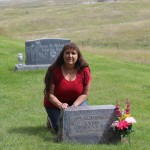
 the stone. Before long, we were at my mom’s grandfather, Cornelius George Byer’s grave. The record I had also showed his dad buried there in Gordon, but we could not find that one, even with the directory, so the records I had found could be wrong. I really wished that we could have found that one too, because it would have cleared up some possible errors in the spelling of the Byer name too, but I guess that one will be a story for another day and another trek.
the stone. Before long, we were at my mom’s grandfather, Cornelius George Byer’s grave. The record I had also showed his dad buried there in Gordon, but we could not find that one, even with the directory, so the records I had found could be wrong. I really wished that we could have found that one too, because it would have cleared up some possible errors in the spelling of the Byer name too, but I guess that one will be a story for another day and another trek.
 As a writer, I don’t usually have very much time for reading. Yesterday, however, on a long drive with my mom and sister, Cheryl, heading to Wisconsin to visit our family out there, I found myself with a few minutes to read. Since being in contact with Jerry Schemmel, who is a survivor and hero of the United Flight 232 crash in Sioux City, Iowa, I have been thinking a lot about the plane crash that took my Great Aunt Gladys’ life. Jerry wrote a book about his experience, and I have purchased that, but while waiting for that book, I had started another book about that flight, and the miracle that it really was. There is much that we really had no idea about when that crash took place 25 years ago July 19th. For one thing, the DC-10 should not be able to fly…at all…with the hydraulics gone, and yet that crew managed to keep that plane in the air for an astonishing 45 minutes after losing the number two engine and all of their hydraulics.
As a writer, I don’t usually have very much time for reading. Yesterday, however, on a long drive with my mom and sister, Cheryl, heading to Wisconsin to visit our family out there, I found myself with a few minutes to read. Since being in contact with Jerry Schemmel, who is a survivor and hero of the United Flight 232 crash in Sioux City, Iowa, I have been thinking a lot about the plane crash that took my Great Aunt Gladys’ life. Jerry wrote a book about his experience, and I have purchased that, but while waiting for that book, I had started another book about that flight, and the miracle that it really was. There is much that we really had no idea about when that crash took place 25 years ago July 19th. For one thing, the DC-10 should not be able to fly…at all…with the hydraulics gone, and yet that crew managed to keep that plane in the air for an astonishing 45 minutes after losing the number two engine and all of their hydraulics.
That situation…total loss of hydraulics should have immediately thrown the plane into a rollover situation…meaning that it should have rolled onto its back. The events that would have followed should have been a fast spiral downward, causing the wings and tail to break off of the plane. The plane should have then gone barreling into the ground like a rocket, resulting in the instant death of all persons on board. The fact that none of the things that should have happened…did happen, caused all those who were trying to help the plane to assume that the pilots has misdiagnosed the problem that the plane had. Some even assumed that they could land in Chicago, Illinois, instead of Sioux City, Iowa. I’m sure that to the crew, this all seemed incredible. The people helping them should have known that they knew how to  read their instruments, and they did, but what they were saying was impossible…totally impossible. Nevertheless, it was happening, and the pilots were flying it…against all odds…against the impossible. They even called the people at United Airlines Systems Aircraft Maintenance, also known as SAM to see if they could help. They thought the pilots had misdiagnosed the problem too, until they confirmed that the hydraulic fluid had all leaked out. The people at SAM said later that they had no idea what to say to the crew, because they felt like they were talking to four dead men. They didn’t believe anyone could survive it.
read their instruments, and they did, but what they were saying was impossible…totally impossible. Nevertheless, it was happening, and the pilots were flying it…against all odds…against the impossible. They even called the people at United Airlines Systems Aircraft Maintenance, also known as SAM to see if they could help. They thought the pilots had misdiagnosed the problem too, until they confirmed that the hydraulic fluid had all leaked out. The people at SAM said later that they had no idea what to say to the crew, because they felt like they were talking to four dead men. They didn’t believe anyone could survive it.
There was no procedure for a full loss of hydraulics. Flight simulators didn’t teach that scenario, because it was not considered survivable. It had never happened…and if it had, no one survived, because this was not a survivable event…at least it wasn’t until that day. This pilot and co-pilot were flying by the seat of their pants, and the normal fixes wouldn’t work. Captain Al Haynes simply moved on instinct when he used the throttles. He thought he had seen something in the manual about it, but I’m not sure it was there, because it was not supposed work. He was basically using power to control the plane. The plane wanted to turn over, and so, using asymmetric thrust, he was able to keep it making wide loops, and finally ended up at the airport. It would also take the help of a fourth person to make this work. Thankfully they had DC-10 instructor, Dennis Fitch on board to handle the extra need. Each loop caused them to lose altitude, and so at one point they didn’t think they would make the airport. In the end, they had to use a runway that had not been used or maintained in a year. That did not contribute to the crash, however.
I have watched the crash video many times, and you can see that the crew…and I do say the crew, because it took all three of them, and the instructor to run all 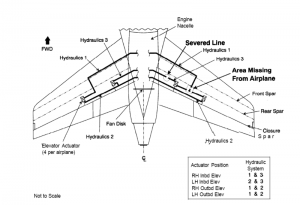 the controls that it took to maneuver the plane…almost landed the plane safely. They were so close. Then the plane tried one more time to roll over, causing the right wing to tap the ground. That was all it took to cartwheel the plane down the runway. In watching that crash, I have no idea how anyone survived it at all…much less more than half of the occupants, including all of the crew. It was a miracle of God, and an answer to the many prayers that were being prayed on board that day. I wish Aunt Gladys had survived, but that was not to be. Nevertheless, there were many heroes that day, and the crew who flew that plane were definitely the greatest.
the controls that it took to maneuver the plane…almost landed the plane safely. They were so close. Then the plane tried one more time to roll over, causing the right wing to tap the ground. That was all it took to cartwheel the plane down the runway. In watching that crash, I have no idea how anyone survived it at all…much less more than half of the occupants, including all of the crew. It was a miracle of God, and an answer to the many prayers that were being prayed on board that day. I wish Aunt Gladys had survived, but that was not to be. Nevertheless, there were many heroes that day, and the crew who flew that plane were definitely the greatest.

